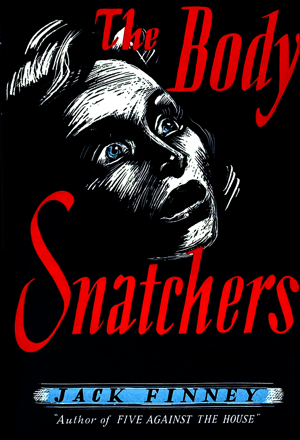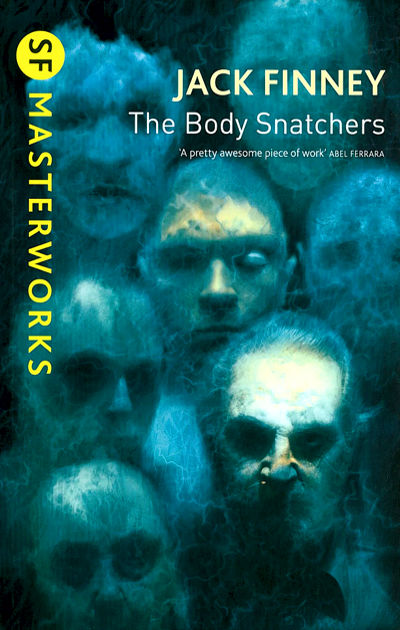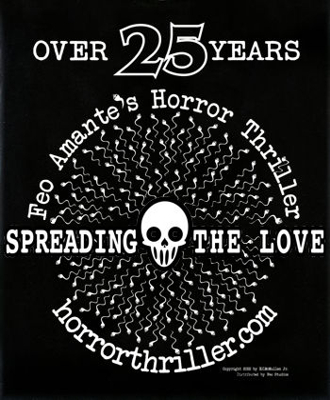 |
 |
Review by E.C. McMullen Jr. |
||||

THE BODY SNATCHERS- 1955by Jack Finney USA Release: Jan. 1, 1955 Dell Publications |
||||||
"Feo!" Someone might say, "there are so many new books to read, why are you reviewing old books?"
"They keep getting made into new Hollywood movies and Television shows." I'd answer, and it's true.
Shirley Jackson's THE HAUNTING OF HILL HOUSE was made into two movies and a recent (2018) television mini-series. Jack Finney's THE BODY SNATCHERS was made into four movies and now there's talk about a television series.
In both cases with both writers, neither haunted house stories or alien invasion by varmints that look like us or control us were anything new upon the release of these novels and series (BODY SNATCHERS, like FRANKENSTEIN, was originally released as a serial in a magazine).
So why, with so many stories that came before these two, did these tales somehow rise to the top? Are you a writer or someone who dreams of writing? Good.
That's what I hope to tell you.
I'll start with the age group. You may like author John W. Campbell. I do and when he released his alien invasion short story Who Goes There, in 1938, it burst a damn somewhere in the still nascent Science Fiction genre which was still trying to decide on what to call itself (besides Hugo Gernsback's "Scientifictions"). It was original because they were Aliens, but relied on hoary old supernatural Horror stories on the same theme: Doppelgänger. A creature that makes itself look like you and takes over your life. Supernatural Vampire and possession stories where the person who looks like your beloved spouse, child, or best friend is really controlled by a woodland elemental or a demonic presence within. These are almost always meant to scare children.
In 1951 Universal Pictures turned Campbell's short story into a movie called THE THING. The alien was a type of giant plant that may or may not wish humans any harm. We never get a chance to find out before we try and destroy it, thus lowering its opinion of us.
That same year Robert Heinlein had his story THE PUPPET MASTERS serialized in a Young Adult magazine in September. In December, U.K. author John Wyndham released DAY OF THE TRIFFIDS which, like Universal Picture's wildly popular April release of THE THING, were alien plants that attacked people (unprovoked no less!).
In 1955 Wyndham released THE MIDWICH CUCKOOS. This time the aliens looked like our own human children. John W. Campbell's Who Goes There was still echoing in popular best selling Young Adult fiction nearly twenty years later. That same year, Jack Finney saw Dell Books publish the novel form of his THE BODY SNATCHERS.
The route that Jack took was not to scare children and young adults. THE BODY SNATCHERS is firmly in adult territory and spills its blood in adult ways.
Jack Finney wanted to write a Science Fiction novel over supernatural because he wanted it to seem believable. But Jack was no scientist, so his character telling the story is no scientist.
The story simply begins with this sentence,
"I warn you that what you're starting to read is full of loose ends and unanswered questions."
Like all of us who witnessed something we can't explain, the person telling us the story only knows what he personally experienced. Anything told to him by anyone else he must take on faith and nearly everyone isn't sure just what the hell is happening in the large sense, they only know what is happening in the microcosm - to them personally.
These are grown people. They're past the typical unsure, sexually confused highschool years of not knowing who they are or who they want to be. These are late 20s, thirty and forty-something year olds who, if nothing else, are confident in their identity. THE BODY SNATCHERS plays and preys on that adult confidence, twisting it into doubt and fear. Finney doesn't even tell us the name of the person telling us the story, until around the 10th page, after the seed of insanity takes root.
Dr. Bennell, Miles to his friends, is visited at his practice by an old High School sweetheart that he let slip away in his college years. 28 year old Becky Driscoll is back in the small town where they grew up, Mill Valley. Like him, she is recently divorced. She's not there for a medical condition and this isn't quite a social call. She's worried sick about her cousin Wilma. Wilma was raised by her Aunt and Uncle, they're the only "Mother and Father" she's ever known. Only now Wilma is saying,
"He's not my Uncle Ira anymore."
Intrigued, and finding that Becky's presence fuels an ember that never fully died, Miles goes out with her to her Aunt and Uncle's place, out of town.
Everything about Ira seems fine, for what Miles knows of the man. But when he and Becky talk privately to Wilma it all gets too weird for Miles. Uncle Ira is physically the same right down to the things he remembers, in the most incredible detail, and the old scar on his neck, right down to all of his little mannerisms.
So why does Wilma think Uncle Ira isn't her Uncle anymore?
Because he knows everything Uncle Ira knew and he can recite them by rote - but there's no emotion attached to those memories anymore. Wilma has known her aunt and uncle all of her life. She can tell the difference between when they're being happy or affectionate and when they're acting, and Aunt Aleda and Uncle Ira can't even pull off a convincing act. They can only pretend, mouth the words: Their natural emotional warmth is gone.
 Wilma, horrified, openly asks if she's going crazy, but Miles is a general practitioner and knows he's out of his depth. As gently as possible he promises to get her in touch with his friend Dr. Manfred Kaufman, a psychiatrist in San Rafael.
Wilma, horrified, openly asks if she's going crazy, but Miles is a general practitioner and knows he's out of his depth. As gently as possible he promises to get her in touch with his friend Dr. Manfred Kaufman, a psychiatrist in San Rafael.
In the coming week he'll be sending a lot of his patients to Dr. Kaufman. What the hell is going on in his little North California town?
Also, as a small town doctor, its common for him to make house calls (the story originally took place in the 1950s but Finney updated the story for 1978. I'm sure I never read the original novel, which is an expensive collectible these days), so wherever he is, he's used to being interrupted at home, at the local diner, even while watching a movie at the theater, to rush to an emergency.
Finney constructs a clockwork tale of Horror in THE BODY SNATCHERS, minutes of strangeness add to moments of discomfort and count down to hourly alarms of outright terror.
When Miles' best friend Jack has the movie theater usher ask him to come out to the lobby, Jack is trying to keep a lid on his anxiety. He has something to show Becky and Miles back at his house and he doesn't want to say what it is. He wants Miles to have a clear head about it so the doctor can reassure Jack and his wife Theodora that what they see is a perfectly natural explainable thing.
Of course what they show Miles he can't begin to explain and the more he tries to figure it out the more terrified he becomes. If nothing else, Miles knows from his years of medical school and internship that what is on Jack and Theodora's billard table can't possibly exist, yet there it is. Worse, this thing which can't exist also shouldn't be alive, and yet.
The seriousness of the situation isn't lost on the friends. Miles, trying to rationalize everything, tells them to keep an eye on it and if that thing on the billiard table changes in any way that alarms them, any way at all, "Get the hell out and come get me."
After that alarm warning, Miles takes Becky back to where she lives which is, for the moment, her family house. Finney's minutes are still ticking and Becky blurts out something she's been holding in but was afraid to say, even to Miles. And she wouldn't have if she hadn't just seen what he did.
"My father isn't my father at all!"
All of this time this seeming mass illusion is over here and over there but not everywhere. Even after his best friend is hit with this unexplainable thing, even after Becky feels she's suffering from whatever her cousin is suffering from, Miles still doesn't appreciate the scale this event could have because these kind of things just never happen. Reports of strange and bizarre isolated incidents come and go, never to return, and life goes on.
Wait. Mass illusion? Like Mass hysteria? This calls for a ...
!!!SCIENCE MOMENT!!!: It depends entirely on the event, of course, but there are well known incidents from the far past all the way up to today. For example, What Was the Dancing Plague of 1518? Was The 'Mad Gasser Of Mattoon' A Poison-Wielding Maniac — Or A Mass Delusion? It's Time to Revisit the Satanic Panic In all of these cases and thousands more, the group or groups who had the most to gain through belief in these mass delusions, were the ones who demanded that all skeptics be silenced. "Anyone who doesn't believe that Witches are behind this is in league with Satan!" "Anyone who doubts us wants to kill (Grandma, children, etc.)" |
It's only when Theodora and Jack come racing up to Miles' house, terrified, that Miles can no longer put up a reasonable front and in a panic, races back to Becky's house. The same house where lives a father that isn't her father at all.
Frozen bipedal alien plants, mobile alien shrubbery, pods gently floating to earth, it was all fertile ground for Science fiction writers of the late 1930s and it continued well into the 1960s. Even Ray Bradbury gave it his spin as a parent's nightmare in 1962 with his short story, Boys! Raise Giant Mushrooms In Your Cellar!
Because I'm reading Finney's 1978 update (his novel was getting a reprint to coincide with the motion picture remake release of the same year) I have no idea what changes Jack made besides the obvious - the date in which this takes place. Apparently Finney took on some of the sharper criticisms toward his story by adding the latest science developments, as he understood them and, where he didn't, wisely left them unanswered. Which is a perfectly fine form of story telling, complete and compelling. We still don't know the inciting incident that led to Romero's Living Dead or Kirkman's Walking Dead. This is how the world is now and we have to survive it.
Because Finney stayed to an adult's view of everything, THE BODY SNATCHERS isn't a novel you outgrow. With its strong John W. Campbell rhythms, it stayed with me ever since I first read it at the age of 20 while in the NAVY, and that was quite a long time ago (though long after 1978).
There's a point, in fact, where a desperate Miles calls the only person in the Pentagon he knows, a lowly Lieutenant-Colonel, in order to sound the alarm and, while I was reading it back then I thought "Yep. That's exactly the way an officer would react."
THE BODY SNATCHERS still makes the frighteningly unbelievable, believable and it thrives in every decade, regardless of the L 'ère branchée du jour.
Five Bookwyrms.





This review copyright 2023 E.C.McMullen Jr.
| GET SOME CLOTHES ON | |
| FEO AMANTE'S HORROR THRILLER Created by: E.C.MULLEN JR. |
| COME FOLLOW ME @ Amazon |
| ECMJr |
| Feo Blog |
| IMDb |
| Stage32 |
| YouTube |
| Zazzle Shop |

